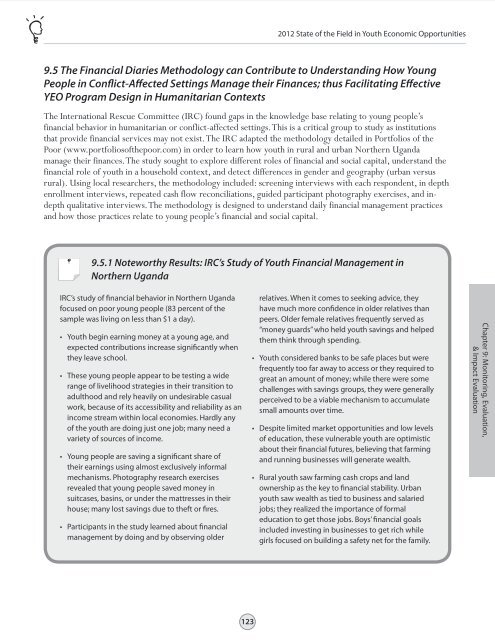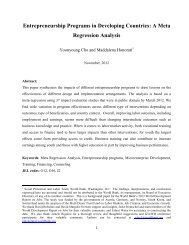STATE OF THE FIELD IN YOUTH ECONOMIC OPPORTUNITIES
STATE OF THE FIELD IN YOUTH ECONOMIC OPPORTUNITIES
STATE OF THE FIELD IN YOUTH ECONOMIC OPPORTUNITIES
Create successful ePaper yourself
Turn your PDF publications into a flip-book with our unique Google optimized e-Paper software.
Table of Contents<br />
Chapter 1 Chapter 2 Chapter 3 Chapter 4 Chapter 5 Chapter 6 Chapter 7 Chapter 8<br />
Chapter 9<br />
Chapter 10 Chapter 11 Chapter 12 Chapter 13 Chapter 14 Chapter 15 Annexes<br />
2012 State of the Field in Youth Economic Opportunities<br />
9.5 The Financial Diaries Methodology can Contribute to Understanding How Young<br />
People in Conflict-Affected Settings Manage their Finances; thus Facilitating Effective<br />
YEO Program Design in Humanitarian Contexts<br />
The International Rescue Committee (IRC) found gaps in the knowledge base relating to young people’s<br />
financial behavior in humanitarian or conflict-affected settings. This is a critical group to study as institutions<br />
that provide financial services may not exist. The IRC adapted the methodology detailed in Portfolios of the<br />
Poor (www.portfoliosofthepoor.com) in order to learn how youth in rural and urban Northern Uganda<br />
manage their finances. The study sought to explore different roles of financial and social capital, understand the<br />
financial role of youth in a household context, and detect differences in gender and geography (urban versus<br />
rural). Using local researchers, the methodology included: screening interviews with each respondent, in depth<br />
enrollment interviews, repeated cash flow reconciliations, guided participant photography exercises, and indepth<br />
qualitative interviews. The methodology is designed to understand daily financial management practices<br />
and how those practices relate to young people’s financial and social capital.<br />
9.5.1 Noteworthy Results: IRC’s Study of Youth Financial Management in<br />
Northern Uganda<br />
IRC’s study of financial behavior in Northern Uganda<br />
focused on poor young people (83 percent of the<br />
sample was living on less than $1 a day).<br />
• Youth begin earning money at a young age, and<br />
expected contributions increase significantly when<br />
they leave school.<br />
• These young people appear to be testing a wide<br />
range of livelihood strategies in their transition to<br />
adulthood and rely heavily on undesirable casual<br />
work, because of its accessibility and reliability as an<br />
income stream within local economies. Hardly any<br />
of the youth are doing just one job; many need a<br />
variety of sources of income.<br />
• Young people are saving a significant share of<br />
their earnings using almost exclusively informal<br />
mechanisms. Photography research exercises<br />
revealed that young people saved money in<br />
suitcases, basins, or under the mattresses in their<br />
house; many lost savings due to theft or fires.<br />
• Participants in the study learned about financial<br />
management by doing and by observing older<br />
relatives. When it comes to seeking advice, they<br />
have much more confidence in older relatives than<br />
peers. Older female relatives frequently served as<br />
“money guards” who held youth savings and helped<br />
them think through spending.<br />
• Youth considered banks to be safe places but were<br />
frequently too far away to access or they required to<br />
great an amount of money; while there were some<br />
challenges with savings groups, they were generally<br />
perceived to be a viable mechanism to accumulate<br />
small amounts over time.<br />
• Despite limited market opportunities and low levels<br />
of education, these vulnerable youth are optimistic<br />
about their financial futures, believing that farming<br />
and running businesses will generate wealth.<br />
• Rural youth saw farming cash crops and land<br />
ownership as the key to financial stability. Urban<br />
youth saw wealth as tied to business and salaried<br />
jobs; they realized the importance of formal<br />
education to get those jobs. Boys’ financial goals<br />
included investing in businesses to get rich while<br />
girls focused on building a safety net for the family.<br />
Chapter 9: Monitoring, Evaluation,<br />
& Impact Evaluation<br />
123

















